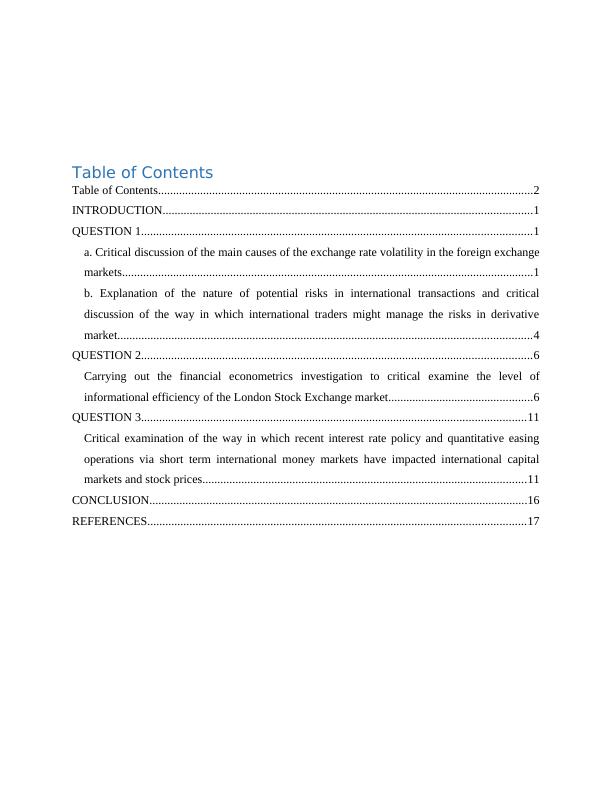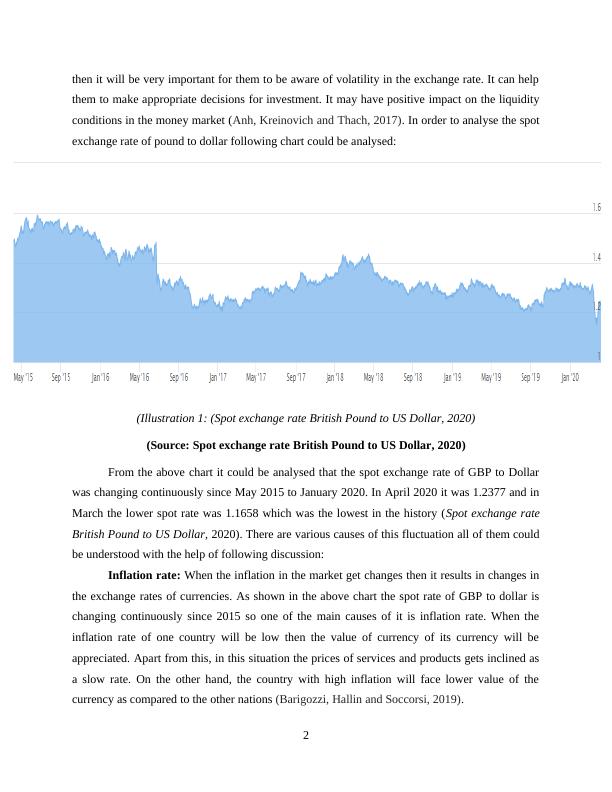Causes of Exchange Rate Volatility and Risk Management in International Transactions
Added on 2023-01-09
20 Pages7009 Words74 Views
Project

Table of Contents
Table of Contents.............................................................................................................................2
INTRODUCTION...........................................................................................................................1
QUESTION 1..................................................................................................................................1
a. Critical discussion of the main causes of the exchange rate volatility in the foreign exchange
markets.........................................................................................................................................1
b. Explanation of the nature of potential risks in international transactions and critical
discussion of the way in which international traders might manage the risks in derivative
market..........................................................................................................................................4
QUESTION 2..................................................................................................................................6
Carrying out the financial econometrics investigation to critical examine the level of
informational efficiency of the London Stock Exchange market................................................6
QUESTION 3................................................................................................................................11
Critical examination of the way in which recent interest rate policy and quantitative easing
operations via short term international money markets have impacted international capital
markets and stock prices............................................................................................................11
CONCLUSION..............................................................................................................................16
REFERENCES..............................................................................................................................17
Table of Contents.............................................................................................................................2
INTRODUCTION...........................................................................................................................1
QUESTION 1..................................................................................................................................1
a. Critical discussion of the main causes of the exchange rate volatility in the foreign exchange
markets.........................................................................................................................................1
b. Explanation of the nature of potential risks in international transactions and critical
discussion of the way in which international traders might manage the risks in derivative
market..........................................................................................................................................4
QUESTION 2..................................................................................................................................6
Carrying out the financial econometrics investigation to critical examine the level of
informational efficiency of the London Stock Exchange market................................................6
QUESTION 3................................................................................................................................11
Critical examination of the way in which recent interest rate policy and quantitative easing
operations via short term international money markets have impacted international capital
markets and stock prices............................................................................................................11
CONCLUSION..............................................................................................................................16
REFERENCES..............................................................................................................................17

INTRODUCTION
International financial market could be defined as a place where different buyers and
sellers of financial assets perform trading related activities. Some of the assets that are traded
through this market are stock, currencies, derivatives, bonds and commodities. There are several
types of markets which are used for the purpose of conducting the trading activities. These are
capital, money, derivatives and commodity markets. For smooth operation of capitalist
economies, it is very important to maintain the financial markets in systematic manner. The
international currency market is the largest financial market at global level where the average
trading of five dollar trillion is performed on daily basis. Large banks and brokers from different
countries performed trading related activities in this market. Some of the main function of the
market are fund mobilisation, easy access, risk sharing, capital formation, price determination,
liquidity, reduction of transaction costs etc. International financial markets are beneficial for all
the investors as well as firms because when the cost of the share will be low then it may attract
large number of investors (Ahelegbey, 2016). Apart from this, these markets also offer
opportunities for risk sharing to the investors. Present report is based upon international financial
markets and econometrics. This assignment covers various topics such as exchange rate
volatility, risks in the international transactions, hedging, forward and future contracts,
examination of the level of informational efficiency of the London stock exchange market,
implication of empirical investigation etc. Additionally, critical examination of the way in which
recent interest rate policy and quantitative easing operations via short-term international money
markets have impacted international markets and stock price are also covered in this report.
QUESTION 1
a. Critical discussion of the main causes of the exchange rate volatility in the foreign exchange
markets
Exchange rate volatility could be described as the risk which is associated with
movements in exchange rate which are unexpected. Some of the main economic fundamentals
like interest and inflation rates play major role in it. In other words, it could be defined as the rate
at which currency of one country is converted in to currency of another country. The rapid
changes or fluctuations in the exchange rates are known as their volatility. When the investors
will be planning to invest in a new country or willing to exchange their currency into another one
1
International financial market could be defined as a place where different buyers and
sellers of financial assets perform trading related activities. Some of the assets that are traded
through this market are stock, currencies, derivatives, bonds and commodities. There are several
types of markets which are used for the purpose of conducting the trading activities. These are
capital, money, derivatives and commodity markets. For smooth operation of capitalist
economies, it is very important to maintain the financial markets in systematic manner. The
international currency market is the largest financial market at global level where the average
trading of five dollar trillion is performed on daily basis. Large banks and brokers from different
countries performed trading related activities in this market. Some of the main function of the
market are fund mobilisation, easy access, risk sharing, capital formation, price determination,
liquidity, reduction of transaction costs etc. International financial markets are beneficial for all
the investors as well as firms because when the cost of the share will be low then it may attract
large number of investors (Ahelegbey, 2016). Apart from this, these markets also offer
opportunities for risk sharing to the investors. Present report is based upon international financial
markets and econometrics. This assignment covers various topics such as exchange rate
volatility, risks in the international transactions, hedging, forward and future contracts,
examination of the level of informational efficiency of the London stock exchange market,
implication of empirical investigation etc. Additionally, critical examination of the way in which
recent interest rate policy and quantitative easing operations via short-term international money
markets have impacted international markets and stock price are also covered in this report.
QUESTION 1
a. Critical discussion of the main causes of the exchange rate volatility in the foreign exchange
markets
Exchange rate volatility could be described as the risk which is associated with
movements in exchange rate which are unexpected. Some of the main economic fundamentals
like interest and inflation rates play major role in it. In other words, it could be defined as the rate
at which currency of one country is converted in to currency of another country. The rapid
changes or fluctuations in the exchange rates are known as their volatility. When the investors
will be planning to invest in a new country or willing to exchange their currency into another one
1

then it will be very important for them to be aware of volatility in the exchange rate. It can help
them to make appropriate decisions for investment. It may have positive impact on the liquidity
conditions in the money market (Anh, Kreinovich and Thach, 2017). In order to analyse the spot
exchange rate of pound to dollar following chart could be analysed:
(Illustration 1: (Spot exchange rate British Pound to US Dollar, 2020)
(Source: Spot exchange rate British Pound to US Dollar, 2020)
From the above chart it could be analysed that the spot exchange rate of GBP to Dollar
was changing continuously since May 2015 to January 2020. In April 2020 it was 1.2377 and in
March the lower spot rate was 1.1658 which was the lowest in the history (Spot exchange rate
British Pound to US Dollar, 2020). There are various causes of this fluctuation all of them could
be understood with the help of following discussion:
Inflation rate: When the inflation in the market get changes then it results in changes in
the exchange rates of currencies. As shown in the above chart the spot rate of GBP to dollar is
changing continuously since 2015 so one of the main causes of it is inflation rate. When the
inflation rate of one country will be low then the value of currency of its currency will be
appreciated. Apart from this, in this situation the prices of services and products gets inclined as
a slow rate. On the other hand, the country with high inflation will face lower value of the
currency as compared to the other nations (Barigozzi, Hallin and Soccorsi, 2019).
2
them to make appropriate decisions for investment. It may have positive impact on the liquidity
conditions in the money market (Anh, Kreinovich and Thach, 2017). In order to analyse the spot
exchange rate of pound to dollar following chart could be analysed:
(Illustration 1: (Spot exchange rate British Pound to US Dollar, 2020)
(Source: Spot exchange rate British Pound to US Dollar, 2020)
From the above chart it could be analysed that the spot exchange rate of GBP to Dollar
was changing continuously since May 2015 to January 2020. In April 2020 it was 1.2377 and in
March the lower spot rate was 1.1658 which was the lowest in the history (Spot exchange rate
British Pound to US Dollar, 2020). There are various causes of this fluctuation all of them could
be understood with the help of following discussion:
Inflation rate: When the inflation in the market get changes then it results in changes in
the exchange rates of currencies. As shown in the above chart the spot rate of GBP to dollar is
changing continuously since 2015 so one of the main causes of it is inflation rate. When the
inflation rate of one country will be low then the value of currency of its currency will be
appreciated. Apart from this, in this situation the prices of services and products gets inclined as
a slow rate. On the other hand, the country with high inflation will face lower value of the
currency as compared to the other nations (Barigozzi, Hallin and Soccorsi, 2019).
2

End of preview
Want to access all the pages? Upload your documents or become a member.
Related Documents
International Financial Markets and Econometricslg...
|19
|6358
|259
Financial Markets: Capital vs Money Markets, Impact of Quantitative Easing, Market Efficiency, Exchange Rate Volatility, Asymmetric Informationlg...
|16
|4863
|387
Financial Instruments And Institutionslg...
|4
|690
|116
Difference between transaction exposure and translation exposurelg...
|2
|599
|491
(PDF) Foreign Exchange Risk in International Transactionslg...
|9
|2241
|274
International Trade and Finance: Capital Allocation and Market Analysislg...
|12
|4171
|85
